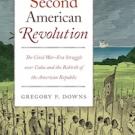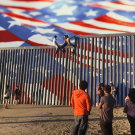
The concept of birthright citizenship is clearly defined in the 14th Amendment to the Constitution, our nation’s most fundamental legal document. Everyone born in the United States is automatically a U.S. citizen.
However, even the Constitution is just a document, said Gregory Downs, a constitutional scholar and professor of history in the College of Letters and Science at UC Davis. He explains the complicated history of laws that undermined equal protections guaranteed by the 14th Amendment, as well as the court case affirming the birthright citizenship we take for granted today.
“Rights are never self-enforcing and there's no language so perfect that having it written down will inherently resolve a problem forever,” said Downs.
What is birthright citizenship according to the 14th Amendment to the Constitution?
Birthright citizenship is national citizenship received automatically by a person born within a nation’s territory. Its foundation in U.S. law is Section 1 of the 14th Amendment to the Constitution, which states, “All persons born or naturalized in the United States, and subject to the jurisdiction thereof, are citizens of the United States and of the State wherein they reside.”
Downs has studied the history of the Constitution extensively and points out that this concept of birthright citizenship was first defined in the Civil Rights Act of 1866. This law was passed after the end of the U.S. Civil War as a way to affirm the rights of Black Americans who were formerly enslaved.
In addition to legally establishing what defines citizenship, the 14th Amendment guaranteed equal protection under the law. Downs said that free Black Americans led much of this push for clarity because their legal status and protections depended on it.
Downs also said that the framers of the 14th Amendment were very aware of how the text could be interpreted after it became law in part because it was so heavily debated by the time it was passed. The Act was passed twice — it was initially vetoed by President Andrew Johnson, then Congress overrode Johnson’s veto to pass it again.
By the time language about the definition of a citizen and equal protections were incorporated into the 14th Amendment, the law’s intention was crystal clear.
“It's rare for a law to be so heavily debated in Congress and then a chunk of that law to be incorporated into a constitutional amendment,” said Downs. “That's a high level of discernment by very able lawyers to make it beyond doubt that Black formerly enslaved people would be protected.”
The 14th Amendment undermined and affirmed in court
Downs said that the main reason to pass a Constitutional Amendments is that they are very hard to change. Amending the Constitution requires support from two-thirds of the U.S. House and Senate or a convention called for by two-thirds of state legislatures, then ratification by 38 of the 50 U.S. states.
Other federal laws that apply to all U.S. citizens in all 50 states can be passed by simple majorities in Congress or struck down by the Supreme Court.
The Supreme Court can also interpret how the Constitution and its Amendments apply to subsequent laws. After the 14th Amendment was ratified, the Supreme Court took no action when states passed laws that established racial segregation that would continue until the Civil Rights Act of 1964 outlawed discrimination based on race, color, religion, sex and national origin.
The definition of birthright citizenship in the 14th Amendment was directly challenged in the 1898 Supreme Court case United States vs. Wong Kim Ark. Ark, who was born in San Francisco, traveled to China, then, upon returning home, was denied entry by U.S. agents citing the Chinese Exclusion Act.
According to the 14th Amendment, Ark was a U.S. citizen. The Supreme Court affirmed his protection under the 14th Amendment, which also affirmed a definition of birthright citizenship that continues to stand today.
New challenges to birthright citizenship in the U.S.
The interpretation of birthright citizenship that has stood since 1898 is today being challenged based on the phrase, “…and subject to the jurisdiction thereof…” The idea is that the children of undocumented immigrants are not subject to the jurisdiction of the U.S. because of their parents’ immigration status.
Downs said that this technical phrase in the 14th Amendment is a historical reference. At the time the Amendment was passed, some Native Americans who were born in the U.S. were living and operating within broader American society but not under the jurisdiction of the U.S. government. For different reasons, so too were foreign diplomats not under U.S. jurisdiction.
“There was the idea that native people could become citizens if they were taxed, but that native Americans beyond U.S. control were not citizens,” said Downs.
This would change in 1924, when Native Americans were made U.S. citizens under the Indian Citizenship Act.
Downs points out that even now there are also technical exceptions to a person receiving citizenship by birthright. The children of diplomats from other countries don’t automatically receive U.S. citizenship. Neither does someone born on a transit ship in a U.S. harbor. However, in neither case are these people subject to U.S. law in the way that undocumented immigrants and their children are.
“I think a logical question that would emerge, though maybe not a legal one, is if the administration truly believes that foreign nationals aren't subject to the laws of the United States, why are they ordering their arrest and deportation?” said Downs.
The integrity of the U.S. Constitution
Even if the U.S. Supreme Court can’t change the text of the 14th Amendment to the Constitution, they may still have the final word. In a future court case, they may decide how the Amendment applies to other federal laws and policies.
Even though the Supreme Court decided that Wong Kim Ark was a U.S. citizen by birthright, two justices on that court dissented. They argued that Ark was not in fact under U.S. jurisdiction regardless of being born on U.S. soil.
This Supreme Court may choose to defer applying the 14th Amendment at all. Prior Supreme Courts declined to strike down laws that stripped equal rights from Black Americans as unconstitutional. Downs said that this shows that public sentiment also plays a part in enforcing even our most fundamental laws, including those written in the Constitution.
“The reason why the Supreme Court didn't overturn those rollbacks is because they didn't see a public outcry,” said Downs. “Public outcry will have an impact on the federal judges who hear any cases that come out of challenges to birthright citizenship today, and those two things in aggregate will have an impact on the Supreme Court if and when challenges to birthright citizenship reaches them.”
YOU MAY ALSO LIKE THESE STORIES

The Second American Revolution
In The Second American Revolution (University of North Carolina Press, October 2019), history professor Gregory Downs argues that we can see the Civil War anew by understanding it as a revolution. More than a fight to preserve the Union and end slavery, the conflict refashioned a nation, in part by remaking its Constitution. More than a struggle of brother against brother, it entailed remaking an Atlantic world that centered in surprising ways on Cuba and Spain.

Weaving Facts Through the Complexity of Global Migration
Migration has also long been a flashpoint for anger and prejudice in every country and context, and these responses can blur the reasons why people relocate their lives and what their arrival means for the places where they settle. The UC Davis Global Migration Center is a research collaboration that weaves facts and human experience into the complexity of how we think about migration, both in the U.S. and globally.
